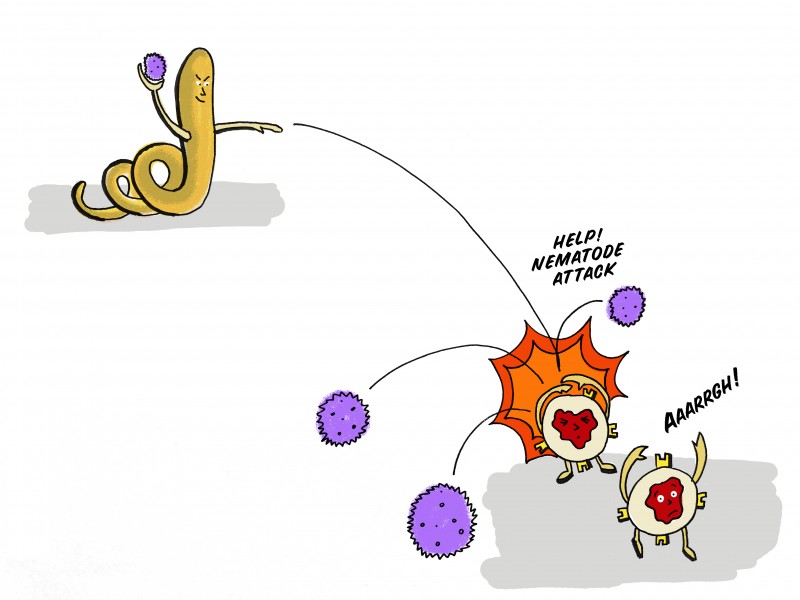By Sophie Arthur
July 3, 2020
Time to read: 8 minutes
It’s that time of year again – the first flush of summer, with the trees and grass still green and flowers everywhere clamouring for attention. Yet just as our eyes feast on this loveliness, many of us start to feel that nagging irresistible itch in the eye; the inconvenient interruption of an impending sneeze; or much more severe symptoms such as the onset of asthma, all of which can encourage a hasty retreat indoors again.
Both hayfever and asthma are good examples of conditions caused by overactive immune systems. Our immune system is typically viewed as the knight in shining armour, there to defend us against all manner of invasions. Without it, we would struggle to survive, as even the most innocuous bug could kill us. Yet, many diseases, ranging from the inconvenience of mild hayfever to life-changing diseases such as Lupus, result from inappropriate activation of the immune system. Overactive immune cells can start to attack innocuous substances, such as reacting to pollen in the air, or even turn on the body’s own cells as in autoimmune conditions like Lupus. It’s even thought that some of the fatalities caused by COVID-19 infection results from an attack of the immune system on the body’s own lung cells.
So why should our immune system have this propensity to get out of control and damage our bodies in this way? It’s becoming increasingly clear that a major part of the answer is worms.
For quite some time, epidemiologists have noticed that diseases such as asthma, hayfever and autoimmune conditions are much more prevalent in the affluent Western world than in poorer countries such as sub-Saharan Africa and India. When they looked into potential causes for this, one difference really stood out: the prevalence of parasitic worms, which are ubiquitous in less developed countries, but much rarer in Europe and most of the USA. Interestingly, there is growing experimental evidence from studies in mice that the presence of these worms acts against the development of disorders caused by overactive immunity.
One possible explanation for this is known as the “hygiene hypothesis”. Parasitic worms, just as any parasite, have to battle constantly with the host to prevent the body removing them. To do this, they have evolved an arsenal of chemicals that they use to suppress the body’s immune system to prevent them from detecting and killing the worms. The hygiene hypothesis supposes that throughout human history, the majority of the population was infected with parasitic worms most of the time. As a result, our immune system had to evolve so that it was strong enough to battle other infections whilst being dialled down by the parasitic worms – just as you might turn your headphones up when on a noisy train. When you step off the train onto a quiet platform, suddenly the noise of the headphones feels deafening. In the same way, when there are no parasitic worms around, the immune system is too strong and liable to attack anything in sight, resulting in the symptoms of asthma or autoimmunity.

This is a beautiful theory and presents an immediate idea for a cure for these diseases. If only it were that simple however! Parasitic worms are far from harmless inhabitants of the body – as they can cause potentially fatal diseases; in addition, they impose a constant burden on the body’s resources leading to malnutrition and fatigue. So instead, the major prize is to work out what the parasitic nematodes make in order to dampen down the immune system. If we could figure this out, then we could use it as a drug to treat allergies, asthma and autoimmune disorders – a real prize!
It’s in an attempt to contribute to this search where the recent work from the Epigenetic Inheritance and Evolution group in collaboration with Murray Selkirk’s lab in the Department of Life Sciences, Imperial College London, has been focussed. We became very interested in the possibility that some parasitic worms might be secreting types of small RNA molecules known as microRNAs. microRNAs are tiny segments of RNA, only about 20 nucleotides long, yet have hugely important roles in development of many different types of cells, including in the immune cells. MicroRNAs exert their function by pairing to specific target messenger RNAs (mRNAs) and causing these to be shut down. This enables microRNAs to repress a very specific set of genes. Crucially, many of these RNAs are incredibly well conserved. For example, the microRNA known as let-7 has exactly the same sequence in worms, flies and humans – the same 20 nucleotides conserved for more than 500 million years! This makes it very difficult for the host to develop a strategy to block microRNA attacks from parasites as it relies on so heavily on microRNAs that are so similar between the parasite and the host.
The challenge for the parasite in getting microRNAs to the host cells, however, is considerable. The worm would have to export the microRNAs from inside its own cells and then get them into the cells of the host. But the journey for a lonely RNA molecule between two cells is perilous. RNA is intrinsically quite unstable and the environment has a lot of enzymes that chop up RNA. However, pioneering work discovered a potential solution to this degradation problem. It found that parasitic worms release microRNAs encased in “vesicles”- delivery vehicles that bud off from the cell thus enclosing their cargo in a protective membrane.
The second problem is one of delivery. It’s difficult to imagine how the worm could make sure that enough vesicles, containing enough microRNAs, can be delivered into each target cell to have a reliable effect on the host cells. Once they get into the cell there’s also the question of how they would be able to incorporate themselves into the host system of gene repression.
In our work, we decided to use a species of parasitic round worm called Trichinella spiralis. We chose this worm because it has a very unusual lifecycle. Larval worms infect muscle cells of a variety of mammalian species, including humans. There they remain as larvae, potentially for many years, until the host is predated on. The larvae are released when the meat is digested in the predator’s stomach and triggers their development into adults. The adults frantically mate in the intestine and release new larvae. The larvae then undertake a remarkable odyssey, burrowing into the intestine and migrating to muscle cells. Perhaps the most striking feature of the lifecycle is that once they reach the muscle, they actually enter the muscle cell itself where they make themselves comfortable until the next predation event.
The very different environments of the adult and larval stages presented a great opportunity to study microRNA secretion. The adult is extracellular, in the intestine, and the larvae are intracellular in the muscle. Both have to somehow make sure that the immune system doesn’t recognise them, either within the muscle cell or within the intestine. We isolated the RNA secreted by each of these life stages – demanding and time-consuming work that was performed by an excellent PhD student Pete Taylor, and tested what sort of RNAs were found, and how they were packaged up.
We found that both stages of Trichinella released microRNAs. In adults, these were mostly safely contained within vesicles, just as thought for other worms. However, we were very surprised to find that the microRNAs secreted by the larvae were not found in vesicles! Instead the larvae were secreting the microRNAs outside of vesicles. Importantly, we showed that the larvae still secrete a comparable level of vesicles to the adults, but the vesicles just don’t contain many microRNAs. The extremely high percentage of microRNAs not secreted in vesicles has not been seen in any other worm.
We also looked at the particular types of microRNAs secreted in both stages and found that the larvae released high levels of a microRNA that has almost exactly the same sequence as a mammalian microRNA called miR-31. Intriguingly, this microRNA has a very important role in muscle development where it represses some genes important in mature muscle, thus keeping the muscle in an earlier stage of development. It seems possible that the secretion of this microRNA by the parasite acts in the same way, to transform the cell in such a way that the parasite can remain there.
Our discovery raises many questions, which we are now exploring. We don’t know how the microRNAs are secreted, either in the vesicles or outside of them. Which proteins are required? If we could work out the proteins that deliver the microRNA from the larvae into the muscle cell we could use these to try to improve delivery of RNA in therapeutics. Are the microRNAs released by the adult also important, perhaps in silencing the immune system? If so, adding the microRNAs on their own might be useful in treating allergies, asthma or autoimmune diseases. Finally, is the parasite equivalent of miR-31 able to control gene expression in the host cell? If so, perhaps silencing this microRNA might be a way to treat Trichinella spiralis infection.

Written by Peter Sarkies, Head of the Epigenetic Inhertiance and Evolution group at the LMS and senior author on this study.
‘Trichinella spiralis secretes abundant unencapsulated small RNAs with potential effects on host gene expression’ was published in the International Journal for Parasitology on 3 July. Read the full article here.